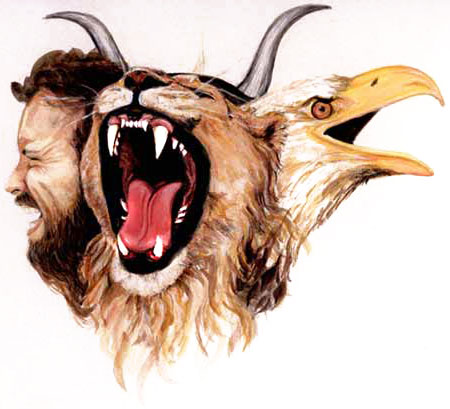Solomon Redivivus
Most commentators, including N. T. Wright, get the Restoration era all wrong. Our history as God’s people is cruciform, which is reflected in the four faces of the cherubim. The Mosaic “bull face” (the Bronze Altar) was replaced with the Davidic “lion face” (the Ark). The Ark was taken by God, and the era of the prophets began, the “eagle face” (the all-seeing Lampstand). Resurrected Israel was to be wise men to Gentile kings, leaven within the kingdoms shown to Nebuchadnezzar. They would not have a Jewish king until the fourth face, the Man, arrived (the Table of Showbread).
So the Restoration era was actually a promotion. Israel’s priestly territory was enlarged, particularly under Persian rule. But once again, they failed to witness, which brings us to the theme of the book of Esther. James Jordan entitles his Esther lectures, “Witness or Perish.”
Commentators also get both the identity (they don’t trust the Bible’s chronology!) and the character of Ahasuerus wrong. Jordan writes:
The king in Esther is a model ruler whose behaviour and whose symbolic associations link him with Yahweh, king of Israel. Since this is pretty much the opposite of what is usually assumed, let us consider the matter a bit.
Commentators vary in how bad they think the king in Esther is, but here is a pretty typical list of his failings:
- He’s a drunkard
- He’s a sexpot
- He’s a weakling
- He’s cruel.
This is all utter rubbish.
First, Ahasuerus is a king who invites all his people to his feast when he has defeated his enemies and rests on his throne. All are invited, rich and poor alike. No one is required to drink anything he or she does not want to. Esther 1:5-8.
Second, when the king is happy with wine, he asks his wife to appear with him before the people, and she refuses. Contrary to mythology, she is not asked to appear naked. Contrary to the imaginations of expositors, she is not asked to appear at a drunken feast. Contrary to many commentators, her refusal to appear makes her an undermining serpent in the king’s garden, an enemy who appears after he thought all his enemies had been subdued.
Third, the king was angry and his wrath burned (1:12), but he did not act upon his anger. Instead he consulted his wise men. Believe it or not, many commentators see this as a sign of weakness rather than a picture of self-control and wisdom!
Along these same lines, when the king finds out that Haman has struch at Esther and her people, he walks out of the room to get himself under control, and listens to the advice of those around him rather than totally trusting his own judgment (7:7-10).
Fourth, it is not the case that soldiers went through the empire and forced virgins into the harem for a night with the king. Nothing like that is hinted at in Esther 2. If Esther went to the palace, it was under the advice of Mordecai.
Fifth, yes, this king collects lots of wives. But so did Solomon, and as we shall eventually see, this king is set forth as a new Solomon (Esther 10:1)…
Jordan goes on (in the next newsletter) to describe how the Jews found it unacceptable that Mordecai was actually the faithless troublemaker at the beginning of the story, and thus invented the apocryphal account of the Lord appearing to him and asking him to carry out the deeds in the inspired account. It seems that for most of this period, the Jews bucked against the God-given protection of the Gentile king, and also their new role of faithful service as advisors. Esther begins with Mordecai’s failure to witness, his possible attempt at seizing power instead of receiving it from God (using Esther as a pawn), and his bad advice to his niece. So Haman was exalted instead, but we know God used it to bring matters to a head. Just like He does with Democrat presidents.
To read the complete article, (including point six!) subscribe to Biblical Horizons newsletter at www.biblicalhorizons.com. Jordan’s lectures are available from www.wordmp3.com



























March 25th, 2010 at 5:33 am
Fantastic! I have been so befuddled about what to think of Esther sometimes. Previous to this post, the only wisdom I had heard went like this. Ruth mentions Yahweh by name a great deal and Esther not at all; the lesson is that God is present when we see his movements plainly or not.